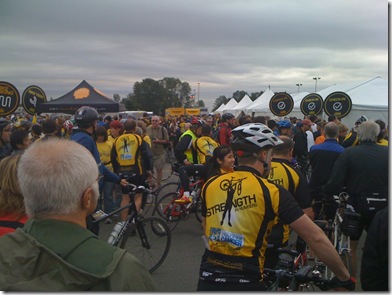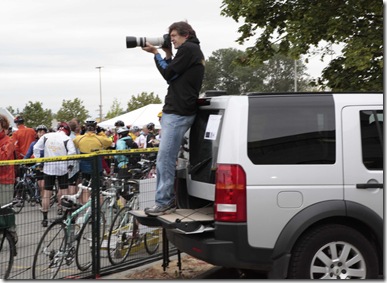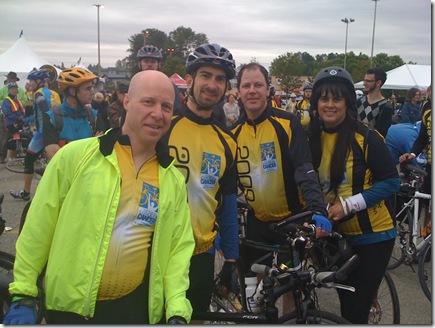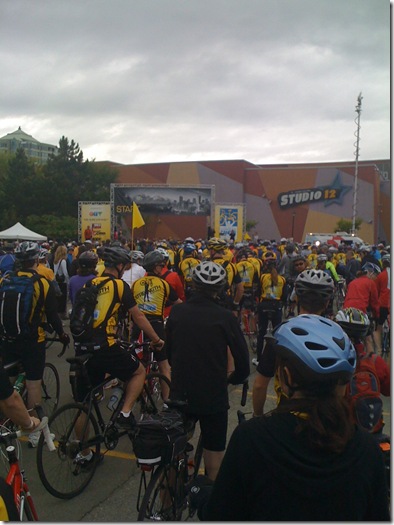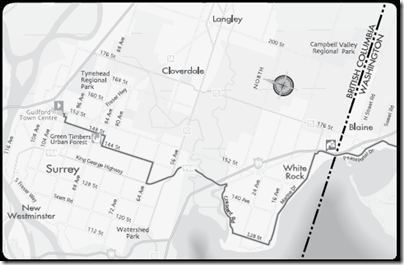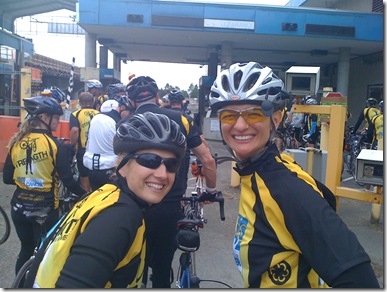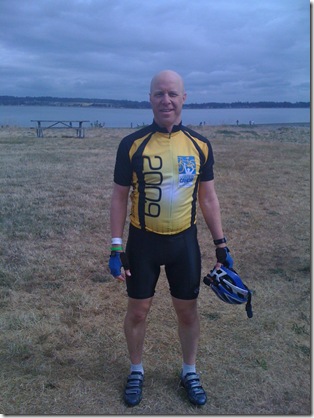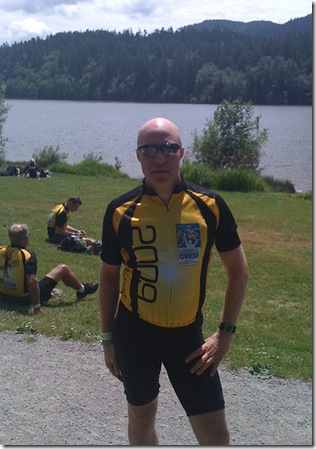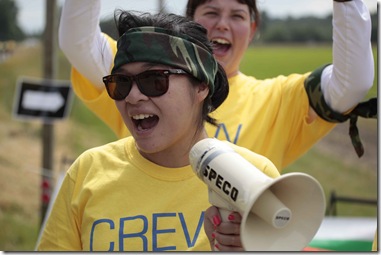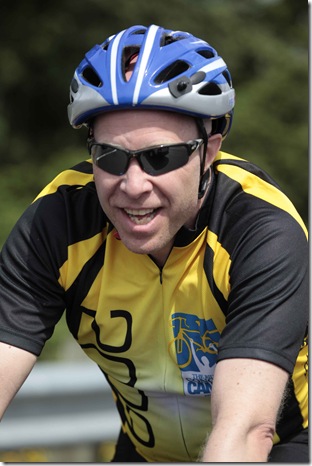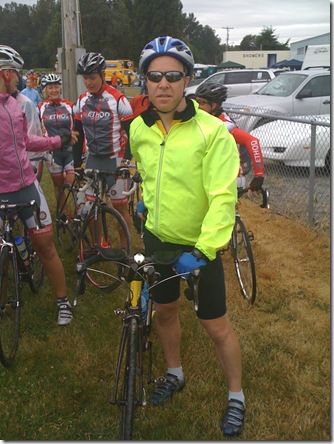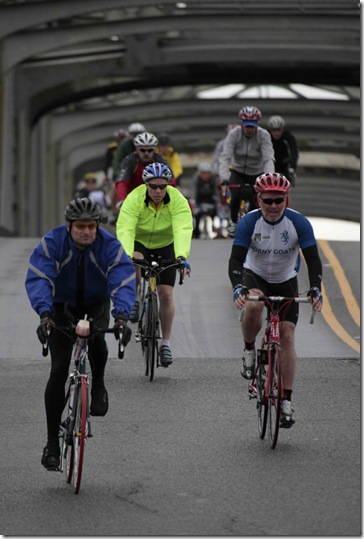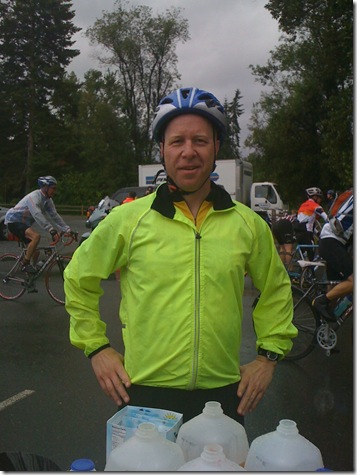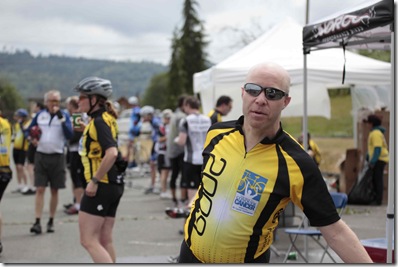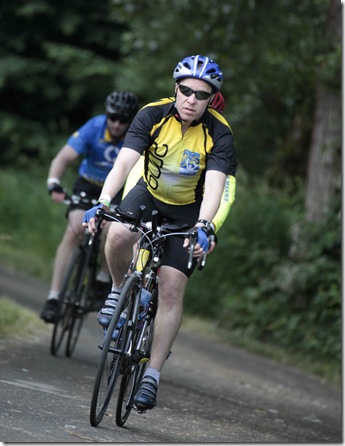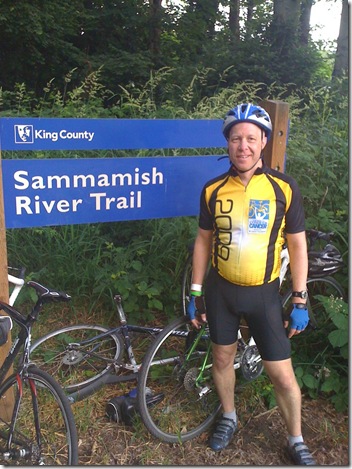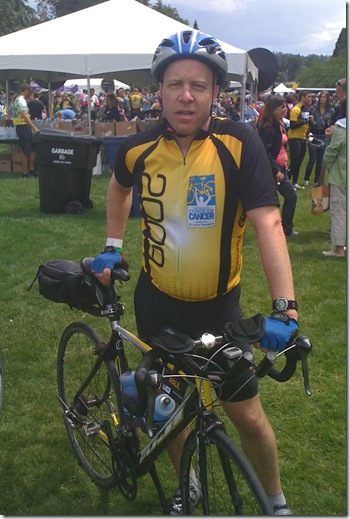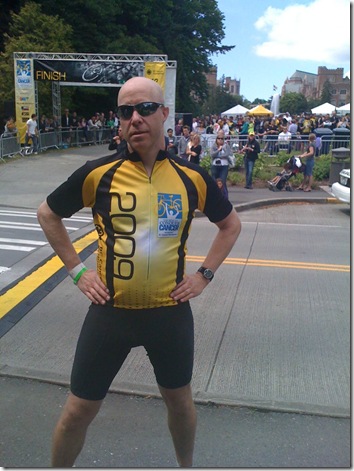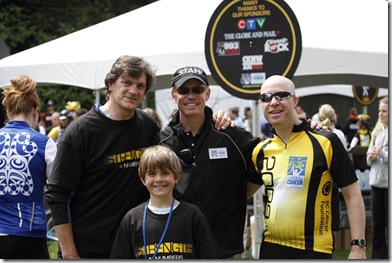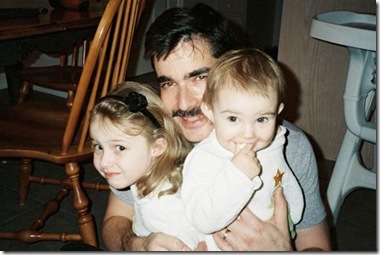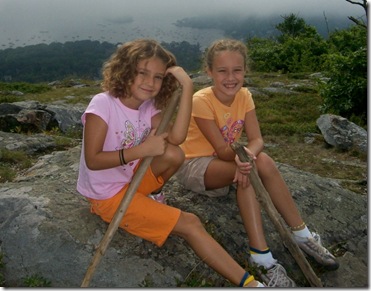I was very fortunate to be able to participate in the BC Ride to Conquer Cancer, a 163 mile (262 kilometer) mile bike ride from Vancouver, BC to Seattle, WA held on June 20 and 21, 2009.
A Word About Fundraising
Before I tell you about my journey, let me mention that the purpose of the ride was to raise money for cancer research and care at the BC Cancer Foundation, Canary Foundation, and Fred Hutchinson Cancer Research Center. The ride raised an amazing amount of money. In fact, we raised 6.9 million dollars (Canadian) for cancer research and care. All of the money raised by Canadian riders will go to the BC Cancer Foundation. And, in fact, most of the money raised will go to this fine organization. Funds raised by U.S. Riders (47 riders) will be donated to the Canary Foundation to support early detection cancer research at Fred Hutchinson Cancer Research Center in Seattle. Read more about the fundraising details.
The Journey from Vancouver to Seattle
Now back to the Ride itself…There were 1,701 riders there on the morning of Saturday, June 20th. Along with us, were numerous loved ones and of course the event organization staff and countless unpaid volunteers. These were the unsung heroes of the ride who made it all happen. All we had to do was ride…
It was cold that morning…
I arose at 5:30 AM, suited up in my ride gear, grabbed my bike that I had parked next to the window Friday night before I went to bed in my room at the Sheraton hotel in Surrey, British Columbia (that’s right, we didn’t actually start in Vancouver, but it was close enough), and my backpack and jumped on the elevator. I rode a couple of blocks to the Guildford Towne Centre mall where I dropped off my pack. At around this time, I ran into my co-worker Philip and his girlfriend Danielle that morning who were there at the event to take photographs and video.
Philip took a few photographs, after which I said goodbye, and made my way to the check-in tent. The ever cheerful and helpful volunteers handed me my ride packet, which consisted of an arm band, a name card, my Ride to Conquer Bike Jersey, some cable ties, and a few other items. A volunteer affixed the bracelet to my right arm along with a special green cable tie that signified I was to get the vegetarian meal plan. I affixed the name card to my bike and proceeded to breakfast, which consisted of a breakfast burrito, a bagel, a banana, and some coffee.
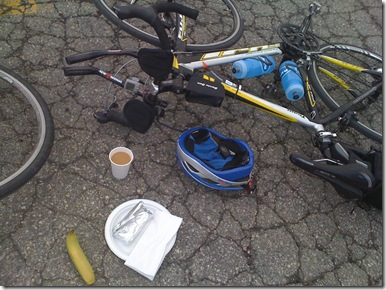
At some point I decided to go to the bathroom. The line to the porta-potties was long but a kind volunteer holding a Starbucks coffee cup mentioned there was a Starbucks not more than a block away. So, I put down my bike and proceeded in the direction of the Starbucks to accomplish two very important tasks: use a bathroom quickly and purchase and consume a split-shot, venti, non-fat latte. After I got back from Starbucks I ran into Damon and Tim (co-workers from Fred Hutchinson Cancer Research Center) and Tim’s wife, Nancy. The four of us are pictured below right before the start (from left to right: me, Damon, Tim, and Nancy).
At 7:00 AM, the festivities started and various dignitaries, cancer survivors, and staff spoke about the ride, cancer, and fundraising.
The Start
At around 7:30 AM, the Ride began and after about 5 minutes or so we made it past the starting point and were able to mount our bikes and start riding. Unfortunately, during the waiting around, my muscles had tightened up, and after a couple of hills I noticed that my quads were quite tight and, in fact, they remained tight for most of the morning.
Regardless, I was excited, and although I had started pretty far in the back of the pack, I pushed myself and worked my way up towards the front during the first 20 miles of the ride. We proceeded south from Surrey towards the border via the “beach” town of White Rock.
The Border
At the border, we all queued up in two bike lines. Once again, we had a chance to get cold as we waited to get through the border. I was fortunate in having to only wait in line about a half an hour. Tim and Nancy who were towards the back of the pack ended up waiting 2.5 hours to cross the border!
Here I am pictured in line at the border. In the background is Canada.
While waiting in line, I chatted with lots of other riders, including Team BC, which stands for Barbara (on the right currently living in Seattle but who had previously lived in Vancouver where she met Christine) and Christine (on the left from Vancouver). You can see the border crossing in front of the these two women. Interestingly, Barbara was the only person I met on the ride (who I didn’t know prior to the ride) who was from the U.S. The vast majority of riders resided in Canada.
After crossing the border, we rode into Blaine and I stopped at mile 30 at my first pit stop, Birch Bay Park in Blaine, WA. You can see me with Birch Bay in the background in this photo taken by one of the great pit stop volunteers, who happened to be wearing a hula skirt!
My muscles started to loosen a bit as we proceeded along the windy Washington coast. At mile 42, we stopped in a parking lot in front of the Silver Reef Casino in Ferndale.
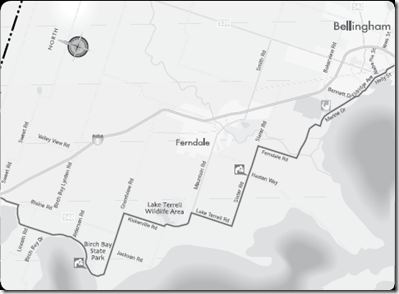
After Ferndale, we headed along the water towards Bellingham. Again, it was windy and I switched off between riding in the streamlined aero position to riding on top of my hoods (that is, with my hands on the tops of my brakes/shifters). I mostly rode alone at this point, occasionally popping in with a group for a while until either I tired and they rode ahead or I increased my speed an passed them. I do remember the miles at this point going quite slowly.
Lunching at Bellingham
Around 11 AM we arrived at the town of Bellingham for what I assumed was the Day 1 lunch break. Bellingham was pretty small and once we arrived there I thought we’d be at the lunch spot within a few miles. No such luck; what seemed like 10+ miles and several steep up hills later we finally saw the volunteers cheering and waving us into the lunch stop at Lake Padden (which was actually South of Bellingham).
The lunch break was a very welcome stop and the setting was almost perfect on Lake Padden at mile 55 for the first day. I was pretty tired at that point and a little cranky since I had expected lunch to be around the next turn for some time.
The staff was, of course, great, doling out lunch, beverages, praise, and sunscreen. My complaints were soon gone as I ate my lunch down by the lake and took a few minutes to bask in the sun on the grass. You can see me here with the lake behind me. I ended up breaking for about 50 minutes on Saturday.
And since it had taken so many miles to get to the lunch stop, it turned out that we had less than 30 miles to go till camp that day.
I took off after lunch and headed for the next stop, 14 miles later at Belfast Feed Store just north of Mt. Vernon in the town of Burlington. At this point, it had gotten rather sunny and so I grabbed some snacks and slathered on some more sunscreen at this last rest stop before we reached camp. I checked my phone and there was a message from Phil asking me where I was. I called him a couple of times and finally got through. He had just pulled into Lake Padden and was wondering as to my whereabouts. He asked me to wait and he would hurry there so he could get some shots of me that day.
So I waited…and waited…and waited. A 15 minute break turned into about an hour which hurt even more because I knew I only had 13 more miles to ride that day. But I impatiently waited for Phil. It was nice to see him and Danielle. After they took some photos at the rest stop and chatted a bit (and a bit more), they took off ahead of me in the car and shot a whole bunch of photos of me as I rode by including these next two.
We soon approached the now barren tulip and daffodil fields of Mt. Vernon. You could hear the cheering from fans and volunteers as we rounded that last turn and pulled into camp. What a rush realizing that I was done for the day!
Camp was pretty cool. A bunch of bike racks, a grub and beer tent, a massage tent, and 700+ sleeping tents stretched out in front of us.
I was certainly sore: I felt it the left side of my neck and my lower back but, to be honest, I felt great for a guy who had ridden 82+ miles that day.
Each rider got two free beers, snacks, dinner, and a free massages. I grabbed my 2 beers and chatted with Damon (my teammate). I also visited the Ride store where I purchased a couple of “Someone I know rode in the Ride to Conquer Cancer” t-shirts for Anna and Matthew.
I waited about 20 minutes in the massage line but it had barely moved and I wanted to get to my hotel room. That’s right, unlike 90% of the other riders, I had made a reservation at a local Days Inn hotel. I am glad I opted for the more comfortable sleeping arrangements.
I stopped off at a nice Italian restaurant in Mt. Vernon where I had some pasta and rode over to the hotel about 2 miles from camp.
After a welcome shower I crashed not too much later that evening but was awoken in the middle of the night with some sort of rash that had me various parts of my body very itchy. I managed to settle back to sleep; in the morning I found patches of red all over my body. I figure I was must of been allergic to the soap in the Surrey or Mt. Vernon hotel.
Day 2: Mt. Vernon to Seattle
After breakfast of waffle and coffee at the Days Inn, I rode back to camp for the beginning of Day 2. Other than the rash (which settled down with some Benadryl and cortisone cream), I have to say I felt great and was excited to start day 2. It had rained over night and it was again quite cold in the morning. When I got to camp I parked my bike near the entry/exit gate and jumped in line for the porta-potties.
After taking care of business, I grabbed my bike where I had left it and interestingly enough was positioned very close to the front of the group. Here I am right before the start. It was about 7:30 when they started everyone on Day 2.
Hanging with the Lead Pack
Here is a shot that Phil took of me coming off the Mt. Vernon bridge (in the bright rain jacket) about a minute into the Day 2 ride.
I really enjoyed the start of Day 2. Because of my fortuitous position at the start I got in with the lead pack. After the bridge I could see this huge lead pack of probably about 60 riders. At first I was a bit intimidated by it, saying to myself that they were going too fast. But then it dawned on me that a group of that size would produce a super draft that I could take advantage of, so I hung on and joined the back of the lead pack. It was great. We were just zooming along at a pace of probably 20 miles an hour (not that I would know because my bike computer battery died towards the end of Day 1 and although I replaced it, the wheel size got reset while replacing the battery and thus it was useless).
Anyway, being in that lead pack was a lot of fun. At one point at about mile 8 we passed this huge group of cows and totally spooked them. They started stampeding along the road (fortunately, there was a fence between them and us) and were charging forward in parallel to us for a few minutes. I was still hanging onto the lead pack when we blew past rest stop 1 at mile 14. A few people stopped, but 90% of the pack—including yours truly—decided to skip the stop and continue riding hard. About a mile later, a group of us lost the lead pack through the town of Stanwood, but I continued to work with several guys for quite a few miles with a reduced albeit still quite fast pace. It was another 18 miles before we arrived at rest stop 2 at the Centennial Trailhead in Arlington. Of course, since the road was wet I splattered with rain and road debris. At this point we were Day 2, mile 32.
Rest Stop
Here I am at that first (for me) rest stop on Day 2 in Arlington. After the rest stop the ride continued on the Centennial trail for another 7 or 8 miles. I kicked it down a notch at first, taking it pretty easy on the very pretty trail. A few miles into the trail, however, I kicked it back up, jumping in with a group and working the last few miles until we reached Lake Stevens and lunch at mile 42—pretty much half way for Day 2.
Lunch and a Latte at Lake Stevens
I pulled into lunch at 10:30. It was cold at lunch and I was freezing, especially after drinking some cold juice. I asked one of the volunteers if there was coffee available and they said no but there was a coffee shop just outside the park and across the street. I grabbed a latte at the coffee shop and chatted with the locals who had lots of questions about the ride and the route we were taking. Sitting down in a comfy chair didn’t help me get going again and all told I spent about 50 minutes at the lunch stop getting going again at about 11:20.
Hills
The Day 2 ride had been pretty flat until now but that was soon to change as we headed off towards Snohomish. The middle school where we stopped for the next pit stop was just past Snohomish so we were already starting to climb out of Snohomish when we stopped for a nice rest at mile 55. Here I am stretching at this rest stop.
After the rest stop we continued to climb out of Snohomish. And boy, was that some climb. In fact, the hills out of Snohomish continued for some time. I was beginning to feel quite tired and sore but I also was pretty jazzed that we only had about 26 miles left!
Sammamish River Trail
At around mile 60 we reached Woodinville and worked our way through town until we reached the Sammamish River Trail. I have to say I was very, very happy when we reached the Sammamish River Trail as I was now on familiar territory. I had ridden this stretch of trail many times while training for the ride and even though I was quite tired this immediately gave me a shot of adrenaline. At this point I saw Phil who took this shot of me on the trail.
After a few miles into the trail, we reached the final rest stop of the Ride at the Sammamish River Trail Park in Bothell, where I asked another rider take this photo of me.
Putting the Hammer Down
I didn’t linger long at this stop because with only about 14 miles left in the ride, I could taste the finish. And the excitement caused me to put the hammer down for the remainder of the ride. Not too long after the rest stop, the Sammamish River Trail ended and the even more familiar Burke-Gilman trail started. At this point, I cranked it up another notch. I was almost home in my mind even if it was 10+ miles. If truth be told I underestimated the remaining distance in my mind and have to say those last 10 miles felt like they would never end. But I kept pushing at a pretty crazy pace. I so wanted the Ride to be over and was determined to kick some butt during those last few miles on my home riding territory.
At this point it had been raining on and off but we were all quite surprised when sometime between 1:00 and 2:00—I think I was in the Lake City neighborhood of Seattle at the time—it started hailing. Yes, it hailed for about 15-30 minutes. And the hail was pretty big. Remember this was on June 21st!
During those last few miles my thoughts turned to my my cousin Paul Kunzinger who had died from Lung Cancer and the others I knew who had suffered by cancer. I also thought about my many amazing sponsors who had helped me raise an amazing $6,000. Wow, this had been so easy…
We made it through the hail, past 125th, 75th, 70th, 65th. Closer and closer. Past University Village mall. At this point it couldn’t be more than a couple of miles and I pushed even harder. I wanted that finish so bad and continued to fly by other riders on the somewhat crowed trail. Past Husky Stadium and the Montlake Bridge, and finally the last turn onto gravel and the last few yards past the finish line in front of University of Washington’s Drumheller Fountain. I got choked up and tears in my eyes as I crossed the finish line.
The Finish…And the Finish
This next photo was taken just a few minutes after the finish. I think you can see how tired I was at that point. But also so excited! I did it. We did it! 1,701 of us had ridden 163 miles from Vancouver, BC to Seattle and in the processraised 6.9 million dollars for cancer research. Wow.
A little while after I finished and half-way into my celebratory free beer I found Phil photographing away at the finish. “Did you get a shot of me at the finish” I asked, guessing he would say no. Indeed, he must have gotten there after me and he asked if I would mind riding across the finish line again. So, I hate to admit it, but I handed my beer to someone, grabbed my bike off the rack, and rode back another couple hundred yards so Phil could capture it on video.
So I circled around and rode across the finish line a second time, almost falling over as I waved my helmet for the video camera. Phil posted a video featuring me on the first day of the ride on youtube. So far he hasn't posted any videos that included the finish redux.
These next two shots were taken after it was all over. The first one with me posing about 20 yards before the finish line and then Phil, his son Will, and Brian Pendleton, the man who ran the whole event.
And Now a Word from My Sponsors
This ride would have been nothing if not for my sponsors. With the help of the following people, I was able to raise over $6,000. Thank you from the bottom of my heart my very generous sponsors. You guys and gals rock!
[One more thing: it's not too late to sponsor me. The Ride folks are still accepting donations until 60 days past the event, which would be until August 20, 2009. If you are interested, please go to My Ride to Conquer Cancer Website. Thanks.]
Kimberly Tripp and Paul Randal
Brad Kingsley
Don Kiely
Jungchan Hsieh
Bradley Millington
Lakeview Financial Group
Anne Kunzinger
Suzanne Litwin
Paul Schwaegler
Peter Vogel
Serge Baranovsky
Richard Campbell
Miguel Castro
Scott Cate
Frances Cerio
Ken Getz
Mark Mason
Michael Neel
Mary Pettinger
Stefan Schackow
Suresh Varghese
Stephen Walther
Bob Kunzinger
Victrinia Ensor and Eric Ridgeway
David Kunzinger
Stu Yarfitz
Andy Greendorfer
Thomas and Joan Litwin
Shirley Beresford
Buzz Brown
Star Dirette
Thomas Eberhard
Peter Kellner
Suzanna Moran
Shawn Nandi
Guy Page
David Rogers
Marty Schaeferle
Scott Sutherland
Craig Utley
Terry Wong
Robert Zelt
Geoff Litwin
Peter Litwin
Lisa Wood
Cathy Kirkwood
PJ Forgione
Alex Homer
Mija lee
Robert MacHale
John McGahan
Marquette Moore
Stephen Presley
Ben Robinson
Dan Wahlin
Paul Waters
William Marty
Dan Balter
Don Brown
Tony Goodhew
Dennis Hall
Linda Mickelberry
Faye Plum
John Durant
